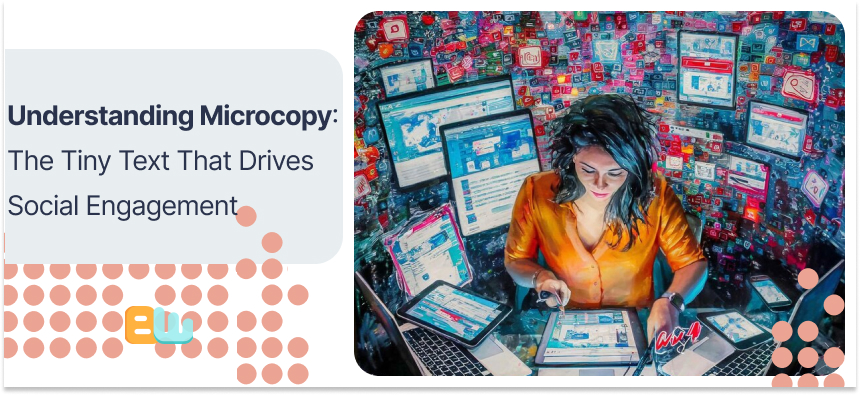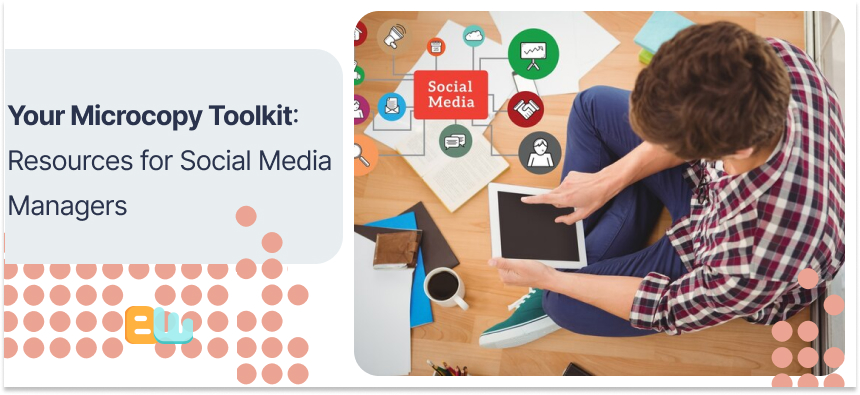
Ever noticed how a simple “Share your thoughts” feels more inviting than “Comment”? Or how “Try it free” creates more urgency than “Sign up”? These tiny text differences represent microcopy—small words making a massive impact on social media engagement.
These little passages of text are what lead users through their social media journey, generating meaningful connections and motivating particular actions, even if we frequently concentrate on creating the ideal post or creating visually appealing images.
We’ll examine how social media microcopy shapes brand personality, affects user behavior, and ultimately decides whether a user interacts with or ignores a post in this in-depth guide. Let’s explore the significance of these seemingly insignificant words.
Understanding Microcopy: The Tiny Text That Drives Social Engagement

Despite its modest size, microcopy has a significant impact on user experience. These brief textual bursts show up on social media sites, subtly directing users and influencing their experiences.
What Exactly Qualifies as Social Media Microcopy?
All of the little textual cues that users need to navigate social media platforms are included in microcopy. This includes error warnings, tooltips, button text, form labels, and prompts for instruction. It’s the “Add to your story” text on Instagram. It’s the field for the “What’s happening?” prompt on Twitter. It’s the “Add a comment…” section that appears beneath posts on LinkedIn.
These brief phrases have important functions: they provide users with guidance on what to do next, describe how features operate, and establish brief interactions between users and platforms.
According to UX designer Sarah Peterson, “microcopy is the digital equivalent of body language in human conversation”.”It’s not the main message, but it significantly influences how that message is received.”
Why These Small Words Matter for User Experience
By decreasing obstacles and providing guidance, good microcopy leads to smooth user experiences. Consider these impacts:
1. Reduced cognitive load: Clear microcopy means users don’t have to think about what to do next.
2. Increased trust: Professional, consistent microcopy signals reliability.
3. Enhanced engagement: The right words can boost click-through rates and participation.
4. Streamlined onboarding: Helpful microcopy can reduce abandonment during sign-up flows.
When Twitter changed its post button from “Tweet” to “Share” in some markets, engagement metrics shifted noticeably. This single-word change altered how users perceived the action of posting.
5 Key Areas Where Microcopy Makes a Massive Difference

While microcopy appears throughout social platforms, five specific areas show its outsized impact on user experience and engagement metrics.
Call-to-Action Buttons: Crafting Words That Drive Clicks
CTAs represent perhaps the most critical microcopy on social platforms. These 1-3 word phrases directly influence conversion rates:
Action-oriented verbs outperform passive language. “Start your trial” generates more clicks than “Free trial available.”
First-person phrasing creates ownership. Pinterest’s shift from “Save” to “Save to board” increased saves by making the action more specific and personal.
Urgency indicators boost immediate action. “Join now” typically outperforms simply “Join.”
When Instagram tested changing “Like” to “Appreciate” in some markets, engagement patterns shifted significantly—proving how even single-word changes impact user behavior.
Test this yourself: Create identical posts but use different CTA phrasings in your captions. Track which versions drive more engagement to optimize your approach.
Profile Setup: Guiding Users Through Information Sharing
Profile completion represents a critical friction point where effective microcopy makes or breaks the user experience:
Progress indicators with encouraging microcopy like “You’re almost there!” increase completion rates.
Field labels should clarify exactly what information is needed and why. “Add work history (helps connect you with colleagues)” performs better than simply “Work history.”
Privacy explanations address user concerns directly. “Only you can see this information” reduces abandonment when requesting sensitive details.
LinkedIn’s profile strength meter with accompanying microcopy suggestions has proven remarkably effective at increasing profile completions—it gamifies the process while providing clear direction.
Error Messages: Turning Frustration into Positive Experiences
Error messages represent critical moments where users might abandon your platform. The right microcopy transforms these potential frustration points:
Humanize the problem: “We couldn’t post your update” feels less accusatory than “Posting error.”
Offer clear solutions: “Try uploading a smaller image (under 5MB)” provides a specific fix rather than “Image upload failed.”
Add personality when appropriate: Twitter’s “Something went wrong” paired with their failed-to-load graphic adds a touch of brand personality to an error experience.
Remember that error messages are opportunities to build trust by being transparent and helpful rather than technical or vague.
Notification Text: Creating Compelling Reasons to Re-engage
Notification microcopy directly impacts whether users return to your platform:
Specificity increases clicks: “Jane commented on your post about marketing trends” outperforms generic “New comment notification.”
Value-focused language highlights benefits of returning: “See who agreed with your comment” creates curiosity.
Emotional triggers drive action: “Your post is getting lots of attention” taps into users’ desire for validation.
Facebook’s evolution from generic notifications to specific, action-oriented alerts demonstrates the platform’s understanding of microcopy’s power to drive re-engagement.
Comment Prompts: Encouraging Meaningful Community Interactions
The text prompting users to comment significantly influences both comment quantity and quality:
Open-ended prompts generate more thoughtful responses: “What’s your experience with this?” versus “Leave a comment.”
Contextual relevance matters: LinkedIn’s “Add your thoughts” for professional content versus Instagram’s more casual “Leave a comment.”
Community-focused language increases participation: “Join the conversation” creates a sense of community versus the more transactional “Comment below.”
YouTube’s change from “Comment” to “Add a public comment…” clarified the public nature of comments, influencing both comment volume and content quality.
Crafting Powerful Microcopy: Best Practices for Social Platforms

Creating effective microcopy isn’t simply about being clever—it requires strategic thinking and understanding your audience’s needs at specific interaction points.
How to Write Concise Yet Compelling Social Microcopy
Powerful social media microcopy follows these principles:
Clarity first: Users should never wonder what will happen when they click a button or complete an action.
Action-oriented: Use strong verbs that clearly indicate what will happen.
Concision matters: Aim for 1-5 words for buttons, under 15 words for instructional text.
Address user concerns: Anticipate questions and address them directly in your microcopy.
A practical approach:
1. Write your first draft
2. Cut it in half
3. Test it with someone unfamiliar with your platform
4. Refine based on their understanding
Remember that what seems obvious to you as a platform designer may not be clear to users. “Your microcopy should never make users feel stupid,” notes UX writer Jen Schaefer.
Platform-Specific Microcopy: Tailoring Words Across Networks
Each social platform has distinct audience expectations and communication norms:
LinkedIn: Professional, benefit-focused language works best. “Expand your network” rather than “Find friends.”
TikTok: Casual, creative, and culturally relevant microcopy resonates. “Stitch this” embraces platform-specific terminology.
Twitter: Concise, witty microcopy matches the platform’s character limits and tone.
Instagram: Visual-focused guidance works well. “Add to your story” clearly indicates the visual nature of the action.
Study each platform’s native microcopy to understand their established patterns before creating your own. Users develop platform-specific expectations about how interactions should work.
A/B Testing Your Microcopy: Measuring Small Word Impact
Even small microcopy changes can significantly impact metrics:
What to test: Try variations in button text, form labels, error messages, and onboarding instructions.
Metrics to track: Measure completion rates, click-through percentages, time spent on tasks, and abandonment points.
Testing strategy: Use large sample sizes (at least 1,000 users per variation for significant results) and test each component separately.
Clarity frequently works better than brevity, as demonstrated by Twitter’s test of “Tweet your reply” versus “Reply” in the comment area, which revealed that the more explicit version boosted response rates.
Voice and Tone: Maintaining Brand Consistency in Tiny Text
Microcopy provides powerful opportunities to reinforce brand personality:
Document your voice attributes: Is your brand friendly, authoritative, playful, or straightforward? Create clear guidelines.
Adjust tone situationally: Maintain your voice while adapting tone based on context—more serious for error messages, more conversational for engagement prompts.
Create a microcopy style guide: Document approved words, phrases to avoid, and examples of your microcopy voice.
Slack’s playful loading messages (“What is this? A center for ANTS?!”) demonstrate how consistent voice creates brand recognition even in utilitarian interface elements.
Common Microcopy Mistakes That Damage Social Media Engagement

These typical pitfalls might cause even well-structured microcopy to backfire.
When Clever Becomes Confusing: Clarity vs. Creativity
While personality matters, clarity should never be sacrificed.
These typical pitfalls might cause even well-meaning microcopy to backfire.
Uncertain action results: Users frequently won’t click at all if they are unable to foresee what will happen when they click.
Industry jargon: Although technical phrases may seem complex, they frequently make understanding difficult.
Excessively informal language: Using too much conversational language can occasionally destroy trust, particularly when making payments or adjusting privacy settings.
The early use of “♥” by Snapchat in place of “Add Friend” caused unneccesary confusion for new users who were not familiar with the platform’s customs. When they later added clearer text labels, user retention improved.
Overlooking Accessibility in Your Social Media Microcopy
Accessible microcopy ensures everyone can use your platform effectively:
Screen reader compatibility: Button text should make sense when read aloud without visual context.
Clear instructions: Avoid directional instructions like “Click the button below” that don’t translate to screen readers.
Enough contrast: Make sure that people who are blind or visually impaired can read the text against the background.
Simple language: Simplify technical terms that could be confusing to people with cognitive impairments or those utilizing translation software.
Inconsistent Voice: Why Your Microcopy Needs Cohesion
Inconsistent microcopy creates a fragmented user experience:
Terminology shifts: Using different terms for the same action (“post” vs. “share” vs. “publish”) creates confusion.
Voice fluctuations: Switching between formal and casual tones makes platforms feel disjointed.
Inconsistent instructions: Similar actions should have similar guidance throughout the platform.
From error warnings to onboarding, TikTok’s youthful, humorous microcopy is remarkably consistent across all touchpoints, resulting in a unified brand experience.
Real-World Examples: Brands Winning With Strategic Microcopy

Looking at successful implementations provides valuable insights into effective microcopy strategies.
Case Study: How Top Social Platforms Optimize User Experience
Adaptive microcopy can boost relevance, as seen by Twitter’s thoughtful prompts, which have evolved from “What’s happening?” to more contextual prompts like “Share your thoughts on what’s happening” during significant events.
Instagram’s action clarity: “Save” versus “Bookmark” testing revealed users better understood the storage function with the more familiar “Save” terminology.
LinkedIn’s profile guidance: Their “Profile strength” meter with specific text recommendations significantly increased profile completions.
What makes these examples successful is their focus on reducing user friction rather than simply sounding clever or branded.
Before and After: Transforming Engagement Through Better Words
Consider these real transformations:
Before: “Error 404: Page not found”
After: “We couldn’t find this page. Let’s get you back on track.”
Result: 24% reduction in site abandonment after errors
Before: “Submit”
After: “Share your story”
Result: 31% increase in form completions
Before: “Notification settings”
After: “Control when you hear from us”
Result: 18% increase in settings page engagement
These examples demonstrate how humanizing technical language creates more engaging experiences.
ROI of Good Microcopy: Measuring Business Impact
Well-crafted microcopy delivers measurable returns:
Increased conversion rates: Button text optimization typically yields 2-5% improvements in click-through rates.
Reduced support tickets: Clear error messages and instructions can reduce support inquiries by up to 30%.
Improved retention: Platforms with consistent, helpful microcopy show 15-20% better retention rates than those with generic, technical language.
When Buffer changed their onboarding button from “Next” to “I’m ready!” they saw completion rates increase by 8%—a significant improvement from a two-word change.
The Future of Microcopy in Evolving Social Media Landscapes

As social platforms evolve, microcopy must adapt to new technologies and user expectations.
AI-Generated Microcopy: Opportunities and Potential Pitfalls
AI is transforming how microcopy gets created:
Personalization at scale: AI can generate microcopy variants tailored to user preferences and behaviors.
Testing optimization: Machine learning can rapidly test thousands of microcopy variations to identify top performers.
Contextual adaptation: AI-powered microcopy can adjust based on user context, time of day, or previous interactions.
However, challenges remain:
Brand voice consistency: AI-generated text may struggle to maintain consistent brand personality.
Cultural nuance: Automated systems may miss cultural sensitivities that human writers would catch.
Over-optimization: Focus on click metrics alone may lead to manipulative rather than helpful microcopy.
Voice-First Platforms: How Microcopy Adapts to Audio
As voice interfaces grow in popularity, microcopy must evolve:
Conversational structure: Voice interactions require more natural language patterns than visual interfaces.
Brevity balancing: Voice responses must be concise enough not to annoy but complete enough to be helpful.
Feedback clarity: Without visual cues, voice interactions need clear verbal confirmations of actions taken.
Twitter’s voice tweet experiments show how platforms are beginning to consider how traditional microcopy concepts translate to audio environments.
Inclusive Microcopy: Writing Small Words for Everyone
The future of microcopy prioritizes inclusion:
Global-first thinking: Microcopy that works across languages and cultures, avoiding idioms and colloquialisms.
Age-inclusive language: Text that works for diverse age groups, avoiding assumptions about digital literacy.
Gender-neutral options: Platforms increasingly offer alternatives to binary gender options in profile setup.
Cultural sensitivity: Recognition that colors, symbols, and terms have different meanings across cultures.
Pinterest’s evolution toward more inclusive categorization systems demonstrates how platforms are reconsidering previously unexamined microcopy assumptions.
Your Microcopy Toolkit: Resources for Social Media Managers

Implementing effective microcopy requires the right tools and approaches.
Essential Tools for Testing and Optimizing Social Microcopy
These resources help improve your microcopy effectiveness:
Hemingway Editor: Checks readability levels to ensure your microcopy is easily understood.
UsabilityHub: Allows quick testing of microcopy variations with real users.
Grammarly: Ensures error-free text, critical for maintaining professionalism.
Google Optimize: Enables A/B testing of different microcopy versions on your platforms.
User recordings: Tools like Hotjar or FullStory show how users interact with your microcopy in real contexts.
Building Your Microcopy Style Guide for Consistent Results
Create a comprehensive guide containing:
Voice attributes: 3-5 adjectives describing your brand voice (friendly, authoritative, playful, etc.)
Word lists: Approved terms, discouraged phrases, and alternatives for common actions.
Contextual examples: Sample microcopy for different situations (errors, confirmations, instructions).
Formatting standards: Capitalization, punctuation, and number formatting guidelines.
This style guide ensures consistency across your platform and provides guidance for new team members.
Quick Checklist: Evaluating Your Social Media Microcopy Success
Before implementing new microcopy, confirm it meets these criteria:
✅ Clarity: Could a first-time user understand this?
✅ Brevity: Is it as concise as possible while remaining clear?
✅ Action-oriented: Does it clearly indicate what happens next?
✅ Consistent: Does it match your established voice and terminology?
✅ Accessible: Will it work for all users, including those with disabilities?
✅ Purposeful: Does each word serve a specific function?
✅ On-brand: Does it reflect your brand’s personality appropriately?
Review your existing microcopy quarterly against these standards to maintain quality as your platform evolves.
Small Words, Big Impact
The most powerful aspect of microcopy is its near-invisibility when done well. Excellent microcopy is rarely seen by users; instead, they have smoother, more intuitive experiences that attract audiences to return to your site.
With social media becoming more and more chaotic, careful microcopy offers a big edge over competitors. It’s the distinction between users who are annoyed by it and those who engage fully.
Effective microcopy is about truly knowing your consumers’ needs at every point of interaction and using language that is clear and helpful to meet those goals, not about using fancy wordplay.
Start by auditing your current microcopy. Identify friction points where users hesitate or abandon actions. Then craft and test improvements based on the principles we’ve explored. You’ll be surprised how these small words can transform your social media results.
#SocialMediaTips #UXWriting
